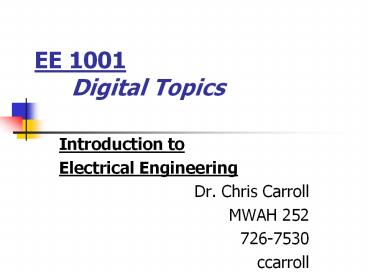EE 1001 Digital Topics - PowerPoint PPT Presentation
Title:
EE 1001 Digital Topics
Description:
Title: ECE 3341 Author: Chris Carroll Last modified by: Stan Created Date: 8/22/2003 8:07:25 PM Document presentation format: On-screen Show (4:3) Company – PowerPoint PPT presentation
Number of Views:35
Avg rating:3.0/5.0
Title: EE 1001 Digital Topics
1
EE 1001 Digital Topics
- Introduction to
- Electrical Engineering
- Dr. Chris Carroll
- MWAH 252
- 726-7530
- ccarroll
2
Digital Logic Circuits
- Foundation for digital computer design
- Basics are easy. . .
- Discrete, two-valued variables
- Finite number of possible functions
- Complex operations built from easy basics
- Combinational circuits (no memory)
- Sequential circuits (memory)
3
Combinational Circuits
AND gate Inputs Output 0 0 0 0 1 0 1 0
0 1 1 1
OR gate Inputs Output 0 0 0 0 1 1 1 0
1 1 1 1
XOR gate Inputs Output 0 0 0 0 1 1 1 0
1 1 1 0
NOT gate Input Output 0 1 1 0
4
Sequential Circuits
- Memory stores state of the circuit
- Implemented with flip-flops
- Clock signal switches 0?1?0?1?
- Flip-flop captures data on clock 0?1 change
- D flip-flop is one of several kinds available
D Q clock
5
Counters
- Simplest kind of sequential circuit
- Count advances once per clock 0?1
- Count sequence determined by circuit
- Sequence advances unconditionally every time the
clock goes 0?1 - Flip-flops store the state of the circuit
6
Binary UP-counter
Now Next QLQR QLQR 0 0 0 1 0
1 1 0 1 0 1 1 1 1 0 0
D QL clock
D QR clock
7
Binary DOWN-counter
Now Next QLQR QLQR 0 0 1 1 1
1 1 0 1 0 0 1 0 1 0 0
D QL clock
D QR clock
8
Gray-Code Counter
Now Next QLQR QLQR 0 0 0 1 0
1 1 1 1 1 1 0 1 0 0 0
D QL clock
D QR clock
9
3-State, Self-Starting
Now Next QLQR QLQR 0 0 0 1 0 1
1 0 1 0 0 0 1 1 1 0
D QL clock
D QR clock
10
Computer Architecture
- How to build a computer
- Many philosophies
- Complex Instruction Set Computer (CISC)
- Reduced Instruction Set Computer (RISC)
- Always three parts of any computer
- Central Processing Unit (CPU)
- Memory (for both program and data)
- Input/Output (I/O)
11
Microprocessors
- CPU portion of a computer on a chip
- Requires external memory and I/O
- Examples
- 4004 (first microprocessor, 4-bit)
- 8080 (popular 8-bit)
- 8086 (16-bit, early PCs used this)
- Pentium (32-bit, 64-bit)
- Others
12
Microcontrollers
- Entire computer on a chip
- Central Processing Unit (CPU)
- Memory
- Input/Output (I/O)
- Easy to embed in larger systems
- Modern cars include 10s of these
13
Hexadecimal (base sixteen!)
- Uses sixteen digits, 0-9 and a-f
- a10, b11, c12, d13, e14, f15
- XY16 X 16 Y
- Or, in binary
- 00002 0 01002 4 10002 8 11002 c
- 00012 1 01012 5 10012 9 11012 d
- 00102 2 01102 6 10102 a 11102 e
- 00112 3 01112 7 10112 b 11112 f
14
Advantage of hexadecimal?
- Easy conversion binary ? hexadecimal
- Each 4-bits of binary is 1 hex digit
- 100101102 9616
- 110100102 d216
- 8a16 100010102
- c316 110000112
15
Summary
- Digital is everywhere!
- Even analog things can be digitized
- Complexity is manageable
- High performance, low cost































